With megapixel surveillance cameras being available in a broad selection of resolutions, how do you know how much is enough? Many salespeople are making huge recommendations as to what to expect from a megapixel camera as an upgrade from a analogue 4CIF camera. Things like 1 camera will replace 5 cameras or even more just are not realistic for most scenes.
Take the following image, which has been provided by The CCTV Blog as an example of 1 camera replacing 16 analogue. While this does give an awesome view, at 8MP the Arecont AV8185 camera provides on this scene an overview to track peoples movement and requires addition cameras to complement it for adequate coverage.
 |
200% zoom from the 8MP 6292 x 1200 pixel Arecont AV8185 |
 |
This is the native resolution of the image, showing the artefacts from the compression. |
Comparing the commonly available 4:3 and 16:9 formats, we have the 4CIF as a base reference, followed by 720p HD, 1080p HD, 1.3MP, 2MP,5MP,11MP and 16MP. For each model, to make measurements consistent we have defined all cameras as being a 1/3” format using a 4mm lens mounted at 2 metres height. We are highlighting the areas that meet the Australian Standards AS4806 definition of identify and Recognise as illustrated below.
 |
 |
|
Regions by colour |
ID & Recognise Regions |
4CIF Resolution
4CIF is the best we have been able to achieve up until about 2007 when megapixel cameras started to hit the commercial market.
 At this resolution we actually struggle to get person identification that meets the standards. A person has to be standing between 1.2 – 1.5 metres from the camera for that perfect shot and the scene is only 1.5 metres wide.
At this resolution we actually struggle to get person identification that meets the standards. A person has to be standing between 1.2 – 1.5 metres from the camera for that perfect shot and the scene is only 1.5 metres wide.
The recognise region is only marginally better being 1.5 – 2.3 metres and 2.3 wide.
Because we want to be able to see under a persons hat if they are wearing one, we have defined 30 degrees as the maximum angle from the horizon, which also restricts the distance.
It is no wonder we get so few convictions on the older CCTV systems if this was the best result we could expect.
720p HD Resolution
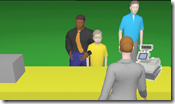 Working at 720p we have a 16:9 aspect ratio which gives for most applications more effective coverage as we have less roof or skyline in the scene to impact on lighting.
Working at 720p we have a 16:9 aspect ratio which gives for most applications more effective coverage as we have less roof or skyline in the scene to impact on lighting.
We can now identify a person at nearly 3m from the camera and 3.2m wide. The recognise range is out to 6m by 7m wide.
The 16:9 aspect makes covering counters ideal due to the extra width as shown here.
1080p Resolution
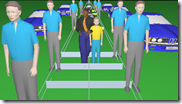 At 1080p we have a similar result as with the 720p due to the wide aspect ratio but with a deeper ID region of 4.5m by 5m wide. The recognise region extends to past 9m by 10m wide.
At 1080p we have a similar result as with the 720p due to the wide aspect ratio but with a deeper ID region of 4.5m by 5m wide. The recognise region extends to past 9m by 10m wide.
1.3MP Resolution
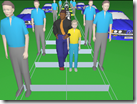 1.3 megapixels gives a similar result to the 720p with the exception of 4:3 aspect ratio so we gain height.
1.3 megapixels gives a similar result to the 720p with the exception of 4:3 aspect ratio so we gain height.
At just over 3m by 3m we get ID quality and recognise at double that.
2MP Resolution
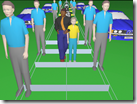 ID is up to 3.7m by 3.7m and as I am sure you are getting to know, recognise is double that.
ID is up to 3.7m by 3.7m and as I am sure you are getting to know, recognise is double that.
The 8MP 180 degree image
above [easyazon-image-link asin=”B0044ZRDIO” alt=”Av8180 camera (8mp, 180 feet, 6400 x 1200 and 4 8mm lens)” src=”http://ecx.images-amazon.com/images/I/21LVeKKK4xL._SL75_.jpg” align=”right” width=”70″ height=”70″]is actually 4x 2MP cameras combined to make one wide image so the same could be achieved with 4 conventional cameras with a better coverage.
3MP Resolution
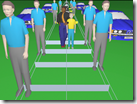
 Getting into the bigger resolutions, we start to get some significant changes in pixel density but it should be noted that we are also increasing the storage and bandwidth significantly to get the same frame rate through.
Getting into the bigger resolutions, we start to get some significant changes in pixel density but it should be noted that we are also increasing the storage and bandwidth significantly to get the same frame rate through.
Our ID limit is now at just under 5m
5MP Resolution

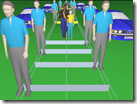 At 5MP many of the cameras cannot produce a full live frame rate due to lack of processing power. You may fine you can only get 5ips, which may not catch the face on the best angle for ID.
At 5MP many of the cameras cannot produce a full live frame rate due to lack of processing power. You may fine you can only get 5ips, which may not catch the face on the best angle for ID.
The range is now 6.3m from the camera for ID.
11MP Resolution
We are pushing 8.3m for ID now but at a huge bandwidth. We are also using 11MP 35mm CMOS chipsets that are more designed for use in digital still cameras. However the results speak for themself.
16MP Resolution
At 10.8m ID coverage, the 16MP is currently the largest megapixel camera commonly available in the CCTV market but only expect 3ips at this resolution and 65Mbps bandwidth at the best quality.
Having seen these used in public spaces such as airports on a dedicated LAN I can say they are impressive as to what can be achieved and I would still recommend using several other cameras at choke points to get the person coming and leaving.
Summary
The invention of the megapixel video surveillance has definitely improved the quality of images but without the fundamental understanding of pixel density, many sites are really no better off. They have a crisper image but are trying to cover too much in many cases with just one or two cameras of a larger megapixel size but may be better off having an additional camera or 2 at a lower resolution and getting much better camera angles and typically less storage requirements.
Looking back to the original image, I can use the one camera with a 180 degree lens and save some time on the installation or I can put in six 720p cameras spread across the 17 isles.
Looking at the examples below, how would you approach this kind of installation? Add your comments below. ![]()
|
180 degree camera Image of the person in the top left of the scene shows the back of the head at a resolution that is of no use. |
|
Individual 720p cameras The camera alignment does not look as nice but we get an ID quality image of the same person in the far left. |


























Definitely the 6 720p camera’s, much better coverage. Less obstacles of the camera are properly placed.
Good article.
I agree. Distance from the camera is quite important, however much you can zoom-in.
El Número de Cámaras es también una ventaja Gigante; menos cámaras es mejor tiempo de instalación y puesta a punto del sistema. Además, mucho mas facil de manejar a la hora de buscar videos.
The number of cameras is also an advantage, less cameras is best time of installation and tuning of the system. In addition, much easier to handle when looking videos.
Really good article. Keep ‘em coming.
Very good article.
The reality is the Facial Recognition done via electronic processing is here and the requirements will be defined by the products used.
The Facial recognition systems we have can work with 4CIF cameras – the only issue being how they match and how close they match. This technology has been haunted by failure because of multiple reasons; the main two are how close they match and the quality of the installation of the CCTV equipment.
From an electronic Facial Recognition point of view the most important thing that will be faced by the CCTV industry will be the ability of installers to properly create the scene.
Common faults that plague the industry with images are mainly warped images – exactly like that shown in this article.
It is all fine and well placing this 4x 2MP camera in one position and covering a large area – but you have to place your head on the side to look at the images correctly on the left and the right. So you now need to ensure your software processing this image is turning its “head” on the side to correctly identify. This is a lot of code and will only drive up the costs of this technology.
Frankly I cannot imagine the software house’s will be interested in correcting poorly installed images relating to this technology.
In future the installers will need to be highly trained and aware of what they are doing and what constitutes a proper image – something currently not considered properly in the CCTV industry.
Think about this, if you have a “fish eye” going on, the size of someone’s face is changing as they cross the image – this means that again someone has to “correct” the image prior to processing.
I have seen this done I believe with a Mobotix camera and software – but are we now crossing into video tampering and will the justice system accepted tampered images that require correcting?
Long story short – from an electronic Facial Recognition point of view you would be better off installing the 6 cameras over the 1.
Robin,
You may be correct about the legal issues of these 360 cameras because they are not giving an unprocessed image.
Interesting to see the first big court case
I agree Robin, 360 cameras sound amazing, but in reality are not that great and complicate matters. (Apart from the cost!)
What an informative article….Good stuff…..
It has so many great security system which might be wonderful for my best safe. CCTV is one the great design for me as well. I have been more conductive by reading this info about CCTV. Thanks for letting this site..
Yes we all love Tim and the rest of this blog. Useful stuff!